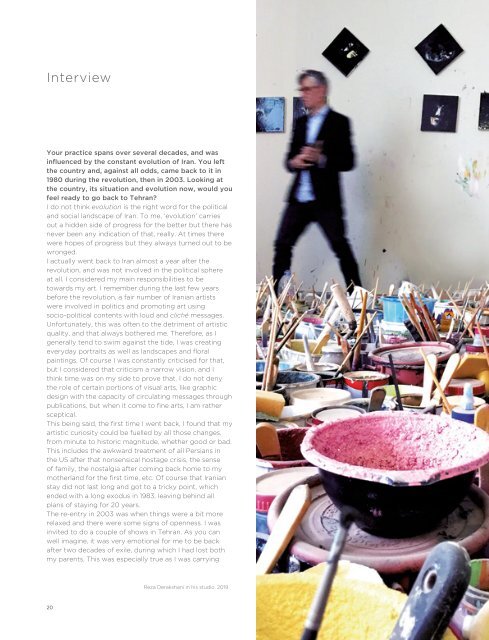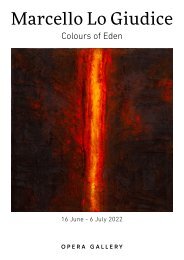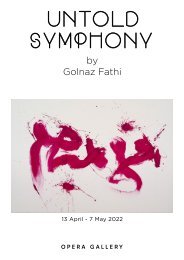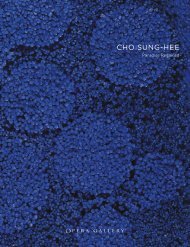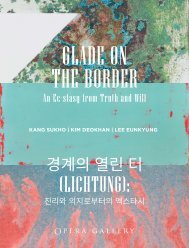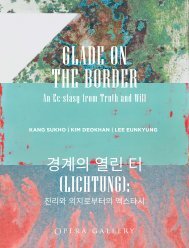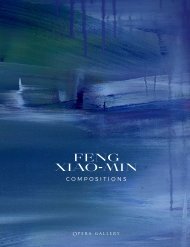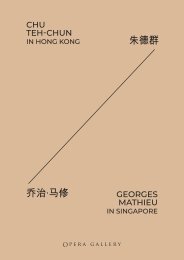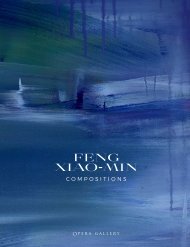REZA DERAKSHANI, A Radiant Fernweh
Reza Derakshani, A Radiant Fernweh Opera Gallery Paris 20 March - 3 April 2020
Reza Derakshani, A Radiant Fernweh
Opera Gallery Paris
20 March - 3 April 2020
Create successful ePaper yourself
Turn your PDF publications into a flip-book with our unique Google optimized e-Paper software.
Interview<br />
Your practice spans over several decades, and was<br />
influenced by the constant evolution of Iran. You left<br />
the country and, against all odds, came back to it in<br />
1980 during the revolution, then in 2003. Looking at<br />
the country, its situation and evolution now, would you<br />
feel ready to go back to Tehran?<br />
I do not think evolution is the right word for the political<br />
and social landscape of Iran. To me, ‘evolution’ carries<br />
out a hidden side of progress for the better but there has<br />
never been any indication of that, really. At times there<br />
were hopes of progress but they always turned out to be<br />
wronged.<br />
I actually went back to Iran almost a year after the<br />
revolution, and was not involved in the political sphere<br />
at all. I considered my main responsibilities to be<br />
towards my art. I remember during the last few years<br />
before the revolution, a fair number of Iranian artists<br />
were involved in politics and promoting art using<br />
socio-political contents with loud and cliché messages.<br />
Unfortunately, this was often to the detriment of artistic<br />
quality, and that always bothered me. Therefore, as I<br />
generally tend to swim against the tide, I was creating<br />
everyday portraits as well as landscapes and floral<br />
paintings. Of course I was constantly criticised for that,<br />
but I considered that criticism a narrow vision, and I<br />
think time was on my side to prove that. I do not deny<br />
the role of certain portions of visual arts, like graphic<br />
design with the capacity of circulating messages through<br />
publications, but when it come to fine arts, I am rather<br />
sceptical.<br />
This being said, the first time I went back, I found that my<br />
artistic curiosity could be fuelled by all those changes,<br />
from minute to historic magnitude, whether good or bad.<br />
This includes the awkward treatment of all Persians in<br />
the US after that nonsensical hostage crisis, the sense<br />
of family, the nostalgia after coming back home to my<br />
motherland for the first time, etc. Of course that Iranian<br />
stay did not last long and got to a tricky point, which<br />
ended with a long exodus in 1983, leaving behind all<br />
plans of staying for 20 years.<br />
The re-entry in 2003 was when things were a bit more<br />
relaxed and there were some signs of openness. I was<br />
invited to do a couple of shows in Tehran. As you can<br />
well imagine, it was very emotional for me to be back<br />
after two decades of exile, during which I had lost both<br />
my parents. This was especially true as I was carrying<br />
Reza Derakshani in his studio, 2019<br />
a false sense of hope that I actually could be helping<br />
towards some cultural progress. Of course that hope<br />
was shattered as well and soon it was time to leave once<br />
more, for the last time, before the situation worsened.<br />
Obviously, I have no intentions of going back as things<br />
are degrading by the day. There are times when you<br />
lose all hope, and I believe those times to be a sorrowful<br />
waste of precious life, as life is too valuable to be<br />
damaged by ignorance.<br />
You declared in 2011 that you had “contributed<br />
enough to the Iranian part in [you]”. Do you now<br />
position yourself as an Iranian artist, a Persian artist,<br />
or a global artist?<br />
I was referring to the contribution into my art and the<br />
promotion of Persian culture. I do value the history and<br />
cultural heritage of my motherland, but prefer feeling<br />
as a global being and therefore a global artist and get<br />
inspired by any interesting culture – including Iranian.<br />
Of course, I am aware that the art world will never<br />
cease to consider me as a Middle-Eastern artist and<br />
that is another interesting challenge by itself.<br />
I consider myself a global artist, born in Iran and<br />
inspired mainly by my Persian cultural heritage.<br />
You are an artist who has lived in Iran and abroad (US,<br />
Italy, Dubai, Russia…). Can you tell us if and how that<br />
experience influences your art?<br />
Naturally we get influenced by our environment, be it<br />
culture, climate, people, nature, etc. I have a foundation<br />
for my work and always build on top of that. Imagine a<br />
tree that can grow anywhere and give new leaves.<br />
Women have always occupied a prominent place in<br />
your works, both visual and written. How do you feel<br />
about the place of women in our current society, both<br />
in the West and in Iran?<br />
I always bow to the strength of women whether in<br />
everyday life or when in a hardest situation where<br />
sacrifice is needed. I have witnessed that in my own<br />
family and on a larger scale in the society.<br />
Obviously, tremendous changes have taken place in<br />
the lives of women in the Western hemisphere, from<br />
personal freedom, to education and even to superiority<br />
but countries like Iran are not in the same situation. What<br />
I have observed in Iran is sad and painful. Being denied<br />
even the most basic rights while bearing the weight of<br />
ignorance on their shoulders makes the women of Iran<br />
my heroes.<br />
I have witnessed a young girl being harassed and<br />
physically battered by the authorities in the streets of<br />
Tehran for wearing colourful attire or showing a portion<br />
of her hair, when it is the nature of a woman to wish to<br />
feel good about herself.<br />
I cannot help but say that it is dismal that almost half<br />
a century ago, women in the same country had a<br />
place in society and were gradually moving towards<br />
having their rights recognised. One look at the archived<br />
images from that era and a quick comparison with what<br />
is happening today tells all.<br />
Some of your committed artworks, such as Gold<br />
Bones, or Identity crisis, are still forbidden in Iran,<br />
and frowned upon in the Islamic world. How does this<br />
make you feel?<br />
Well, this speaks volumes about a very real issue, and<br />
also outlines the reasons why you could be forced to<br />
leave your life behind and run away from your own<br />
homeland. Censorship and cultural/artistic prosecutions<br />
always prevent creative minds from soaring and<br />
blossoming, and are therefore quite damaging. Freedom<br />
in art is as essential as breathing.<br />
The fact that an ideology, no matter which kind, would<br />
force people to live in a certain way and destroy others<br />
is really scary. That is what created fascism.<br />
Your Hunting series draws upon the Persian<br />
miniature tradition. Are they a reflection of nostalgic<br />
attachments to Iran? Are they a way to go back to<br />
Sangsar, the village where you were born?<br />
Originally it was an inspiration from a Persian Manuscript<br />
Painting but I am sure it has to do with my childhood.<br />
Indeed, I was brought up in an environment where the<br />
nomadic lifestyle and similar experiences pace lives.<br />
Both my father and my elder brother were horse riders<br />
and hunters, and some vivid images I keep from my<br />
childhood contribute to this series.<br />
I have to say that the long-winded Hunting series has<br />
been transformed into a multifaceted set of works,<br />
both technically and conceptually. From Figurative to<br />
Abstract Art, from simply Hunting to Hunting the Dawn,<br />
Hunting the Light, Hunting the Colour, Hunting the Day,<br />
Hunting the Night, etc. This collection of works is like a<br />
never-ending story.<br />
As a full-rounded artist, you play several musical<br />
instruments. Does your musical practice evolve with<br />
your painting techniques and your vision? Or are they<br />
two discrete creative entities?<br />
What kind of music do you listen to when working?<br />
Although each is a distinct practice, there is no doubt<br />
they coincide and contradict each other at times. It<br />
has always been a mutually influencing conversation<br />
between both arts.<br />
There was a time when my music was leaning very<br />
much towards traditional sounds, while my visual art<br />
was contemporary. This created a dichotomy that<br />
used to tear me apart, until the inspirations gradually<br />
changed, and music and visual art met halfway.<br />
I believe the intertwining of my music with poetry<br />
greatly affected my art, while many technical<br />
dimensions of art have influenced my music, such as<br />
texture and colour of sounds, all of which are not really<br />
apparent in classical Persian music.<br />
20<br />
21


